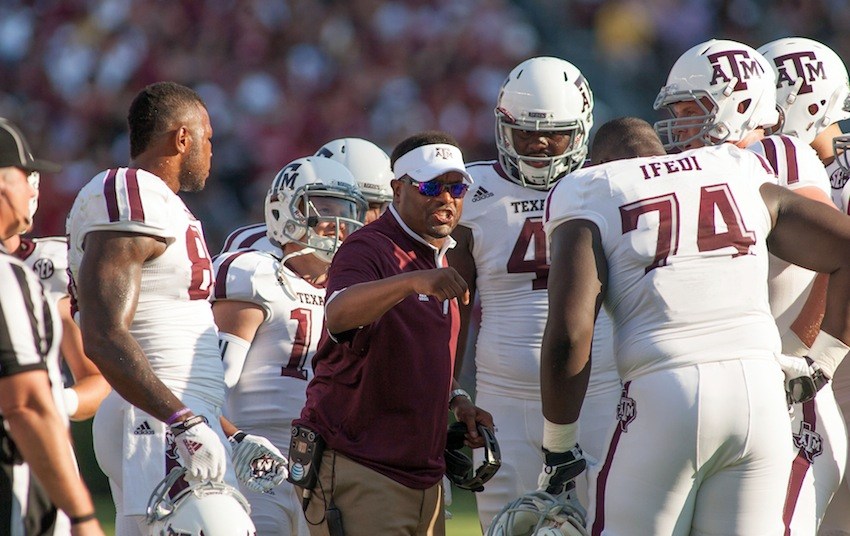2015 State of the Union: Texas A&M Aggies
Johnny Football wasn’t A&M’s singular talent, but the Aggies more or less rode him to a Top 10 finish in 2012 and an excruciating, but entertaining, nine-win season in 2013.
The transition away from the man whose given surname is Manziel started in spectacular fashion last fall and then endured a sharp downturn that stopped short of disaster.
Texas A&M can find plenty of excuses — young, developing, green talent on offense that should continue to improve, and the need for a better defensive coordinator. But 2015 is a crucial season for the Kevin Sumlin era in College Station.
Will all the pomp and circumstance turn into more significant on-field results soon? There are enough pieces in place to really excite an optimist and enough potential holes to sent a pessimist into Eeyore mode, which is what makes this season and this program interesting.
Let’s take a look at the State of the Union, taking into account the last three years and expectations for 2015.
ON-FIELD PERFORMANCE
SEC standing: Middle of the pack
Grade: B-
The Aggies are 13-11 in the SEC the last three years, which is respectable in the SEC West, but the team is trending in the wrong direction: from six conference victories in 2012 to four in ’13 and three in ’14.
Looking at this year’s schedule, the Aggies tentatively will be favored for half of their SEC slate this fall. The team must perform at or above those expectations (meaning four SEC wins minimum) to retain a B-/C+ three-year grade.
The offense was among the nation’s best with Johnny Manziel and remained capable of huge games without him, but the defense has acted as a giant and unwanted anchor, drowning any chance of an SEC championship. Still, the team has played an exciting, very watchable brand of football that’s done great things for the bottom line in terms of revenue and buzz.
RECRUITING
SEC standing: Top third
2015 rank: 11
Grade: A-
You’d be hard-pressed to find more than a handful of schools with a higher-rated recruiting period from 2012-14 than Texas A&M. Other than Alabama, just three SEC schools can make a case: LSU, Georgia and Auburn.
To be fair, some of the top-rated talent still has a chance to develop. But for now, it still seems that for all the team’s touted signees, the Aggies still are light on front seven depth and overall difference-makers.
It’s a relatively minor nitpick; Myles Garrett and Daylon Mack make for a good start up front on defense, and the team is loaded with an All-Star cast of budding young stars on the other side of the ball.
PLAYER DEVELOPMENT
SEC standing: On the fringe of the upper third and middle of the pack
Grade: B
The team loses first-round talent at offensive tackle seemingly every year, then trots out another top-notch offensive line.
Losing Manziel did hurt, but not nearly as much as one may expect, as the offense averaged 35.2 points per game in ’14 despite a mid-year quarterback change and a shoddy defense.
Playing receiver or tight end seems to almost guarantee at least 15 catches, and that’s for the below-average players. Even the running backs, diminutive as they usually are, seem to always churn out a wonderful yards-per-carry average.
But — sense a theme here? — the team hasn’t developed enough defensive standouts.
FACILITIES
SEC standing: Competitive with any team in the conference
Grade: A
The Aggies do not lack for wealthy donors or athletic resources. Not surprisingly, the program is finishing up a three-year, $450 million renovation to Kyle Field.
Oh, and then there’s the Bright Football Complex, a $20.8 million, 36,000-square-foot facility completed in 2014 with a modern new locker room, meeting rooms, coaches offices, sports medicine facility and a hydrotherapy pool with a water wall.
COACHING
SEC standing: Middle of the pack
Grade: C+
The fact that Kevin Sumlin makes $5 million a year affects the grade here. A&M’s coaching may otherwise earn a B-.
Clearly the defensive coaching staff hasn’t met expectations the last three seasons, and in particular during the ’13 schedule. That team finished fifth in the country in scoring offense in Manziel’s final college season (along with Luke Joeckel and Mike Evans), averaging 44.2 points per game. But often it wasn’t enough, as the team lost home games in which it scored 42 and 41 points.
As a result, the team collectively has played slightly below expectations the last three seasons despite an 11-2 finish in ’12. Defensive coordinator Mark Snyder is gone, and one of the best teachers in college football is in his place in John Chavis.
Sumlin sets the expectations bar high with his high salary, elite recruiting classes and high-powered offense. But given all those things, if he goes a third consecutive season without so much as a top three finish in the SEC West, at the least, he’ll be under a ton of pressure in 2016.

